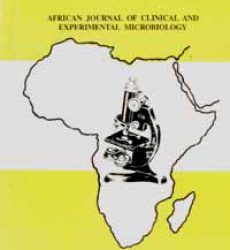*1Akinjogunla, O. J., 2Umo, A. N., 3Alozie, M. F., 2Oshosanya, G. O., and 1Saturday, G. I.
1Department of Microbiology, University of Uyo, P.M.B. 1017, Uyo, Akwa Ibom State, Nigeria
2Department of Medical Microbiology and Parasitology, Faculty of Clinical Sciences, University of Uyo, Uyo, Akwa Ibom State, Nigeria
3Department of Pharmaceutical Microbiology and Biotechnology, Faculty of Pharmacy, University of Uyo, Uyo, Akwa Ibom State, Nigeria
*Correspondence to: papajyde2000@yahoo.com
Abstract:
Background: The emergence of multi-drug resistant bacterial strains worldwide has necessitated the scientific search for novel, potent, and affordable antimicrobial agents including medicinal plants and non-antibiotic drugs for therapy of infectious diseases. The objective of this study is to assess in vitro antibacterial activities and time kill kinetics of some non-antibiotic drugs against pathogenic clinical bacterial isolates.
Methodology: In vitro antibacterial activities including minimum inhibitory concentration (MIC), minimum bactericidal concentration (MBC) and time kill kinetics of Amlodipine (AML), Thioridazine (THI) and Promethazine (PRO) against Staphylococcus aureus, coagulase negative staphylococci (CoNS), Streptococcus spp, Escherichia coli, Enterobacter spp, Klebsiella pneumoniae and Pseudomonas aeruginosa clinical isolates were determined using disc diffusion, broth microdilution and plate count techniques.
Results: The mean growth inhibition zones by the disc diffusion assay of AML, THI and PRO against the isolates were ≤15.1±1.0 mm with MIC and MBC values ranging from 12.5 to 50μg/ml and 25 to 100μg/ml respectively. The time-kill assay revealed bactericidal effect of AML, THI and PRO on Gram positive bacteria evidenced by mean log reductions in viable bacterial cell counts ranging from 0.13 Log10 to 2.41 Log10 CFU/ml for S. aureus, 0.88 Log10 to 2.08 Log10 CFU/ml for Streptococcus spp, and 0.26 Log10 to 2.34 Log10 CFU/ml for CoNS after ≤30hrs post inoculation at 1xMIC. The range of log reduction in viable cell counts of Gram-negative bacteria exposed to AML, THI and PRO were E. coli (0.11 to 3.23 Log10 CFU/ml), P. aeruginosa (0.52 to 2.56 Log10 CFU/ml), K. pneumoniae (0.85 to 3.0 Log10 CFU/ml) and Enterobacter spp (0.38 to 2.08 Log10 CFU/ml) after ≤30 hrs post inoculation at 1x MIC.
Conclusion: These findings demonstrate in vitro antibacterial efficacies and time kill kinetics of AML, THI and PRO against pathogenic clinical bacterial isolates, which indicate that these non-antibiotic drugs may be useful therapeutic alternatives in the bid to reduce the burden of infectious diseases associated with antibiotic resistant pathogens.
Keywords: Amlodipine, Thioridazine, Promethazine, Time-Kill, Kinetics, MIC, MBC, bacteria
Received April 8, 2020; Revised July 12, 2020; Accepted July 13, 2020
Copyright 2021 AJCEM Open Access. This article is licensed and distributed under the terms of the Creative Commons Attrition 4.0 International License <a rel=”license” href=”http://creativecommons.org/licenses/by/4.0/”, which permits unrestricted use, distribution and reproduction in any medium, provided credit is given to the original author(s) and the source.
Editor-in-Chief: Prof. S. S. Taiwo
Activité antibactérienne et cinétique de destruction du temps de l’amlodipine, de la thioridazine et de la prométhazine contre les isolats bactériens cliniques pathogènes
*1Akinjogunla, O. J., 2Umo, A. N., 3Alozie, M. F., 2Oshosanya, G. O., et 1Saturday, G. I.
1Département de microbiologie, Université d’Uyo, P.M.B. 1017, Uyo, Akwa Ibom State, Nigéria
2Département de microbiologie médicale et de parasitologie, Faculté des sciences cliniques, Université d’Uyo, Uyo, État d’Akwa Ibom, Nigéria
3Département de microbiologie et biotechnologie pharmaceutiques, Faculté de pharmacie, Université d’Uyo, Uyo, État d’Akwa Ibom, Nigéria *Correspondance à: papajyde2000@yahoo.com
Abstrait:
Contexte: L’émergence de souches bactériennes multirésistantes dans le monde a rendu nécessaire la recherche scientifique d’agents antimicrobiens nouveaux, puissants et abordables, notamment des plantes médicinales et des médicaments non antibiotiques pour le traitement des maladies infectieuses. L’objectif de cette étude est d’évaluer les activités antibactériennes in vitro et la cinétique de destruction temporelle de certains médicaments non antibiotiques contre les isolats bactériens cliniques pathogènes.
Méthodologie: activités antibactériennes in vitro, y compris la concentration minimale inhibitrice (CMI), la concentration bactéricide minimale (MBC) et la cinétique de destruction du temps de l’amlodipine (AML), de la thioridazine (THI) et de la prométhazine (PRO) contre Staphylococcus aureus, les staphylocoques à coagulase négative (CoNS), Streptococcus spp, Escherichia coli, Enterobacter spp, Klebsiella pneumoniae et Pseudomonas aeruginosa ont été déterminés en utilisant des techniques de diffusion sur disque, de microdilution en bouillon et de numération sur plaque.
Résultats: Les zones moyennes d’inhibition de la croissance par le test de diffusion de disque d’AML, THI et PRO contre les isolats étaient ≤15,1±1,0mm avec des valeurs MIC et MBC allant de 12,5 à 50μg/ml et de 25 à 100μg/ml respectivement. Le dosage temporel a révélé un effet bactéricide de la LMA, du THI et du PRO sur les bactéries Gram positives, mis en évidence par des réductions logarithmiques moyennes du nombre de cellules bactériennes viables allant de 0,13 Log10 à 2,41 Log10 CFU/ml pour S. aureus, 0,88 Log10 à 2,08 Log10 CFU/ml pour Streptococcus spp et 0,26 Log10 à 2,34 Log10 CFU/ml pour CoNS après ≤ 30 heures après l’inoculation à 1 x MIC. La plage de réduction logarithmique du nombre de cellules viables de bactéries à Gram négatif exposées à la LMA, au THI et au PRO était E. coli (0,11 à 3,23 Log10 CFU/ml), P. aeruginosa (0,52 à 2,56 Log10 CFU/ml), K. pneumoniae (0,85 à 3,0 Log10 CFU/ml) et Enterobacter spp (0,38 à 2,08 Log10 CFU/ml) après ≤ 30 heures après l’inoculation à 1 x MIC.
Conclusion: Ces résultats démontrent une efficacité antibactérienne in vitro et une cinétique de destruction du temps des LMA, THI et PRO contre les isolats bactériens cliniques pathogènes, ce qui indique que ces médicaments non antibiotiques peuvent être des alternatives thérapeutiques utiles dans le but de réduire le fardeau des maladies infectieuses associées aux antibiotiques pathogènes résistants.
Mots-clés: Amlodipine, Thioridazine, Prométhazine, Time-Kill, Cinétique, MIC, MBC, bactéries
Download full journal in PDF format below
Antibacterial activity and time kill kinetics of Amlodipine, Thioridazine and Promethazine against pathogenic clinical bacterial isolates

